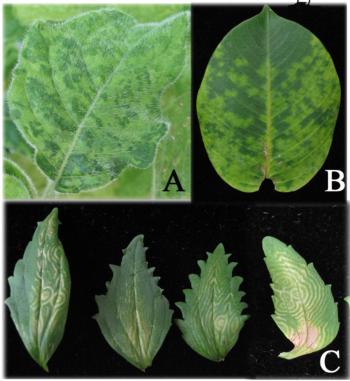DISEASE FOCUS: Developing a successful disease scouting program
by Deborah M. Mathews
Most greenhouse and nursery operations have at least an occasional scouting routine for insects. Fewer have scouts for detecting developing diseases. Such formal scouting efforts are usually done on a weekly or twice monthly schedule by one person or a handful of trained personnel. While it is important that you have regular inspections performed by those trained specifically for that purpose, on a daily basis dozens of workers come into contact with plant products at various stages of their production. Businesses should not overlook the possibility of educating the majority of workers in the basics of disease symptomatology to increase the success of early detection. This article will provide an overview of common signs to look for.
Fungi are responsible for approximately 85% of all plant diseases. Spores and/or mycelium — the fuzzy, hairlike fungal growth structures produced on leaves, stems and flowers of infected plants — can lead to the rapid dissemination of disease throughout an operation (fig. 1A). Symptoms on the upper surfaces of leaves are most obvious, but it is important to turn leaves over and look at the lower surfaces to detect several pathogens including downy mildew (fig. 1B,C). Yellowing, wilting and stunting are signs that root pathogens may be present. When transplanting, an assessment of root health can be made. Healthy roots should be white and crisp, with branching and length appropriate for the age of the plant. Diseased roots will be brown or black and brittle; the outer sheaths may easily separate from the center (fig. 1D).

Fig. 1. White hairlike mycelium and spores of powdery mildew on snapdragon leaves, flowers and stems (A); downy mildew spores on the underside of a leaf (B) with corresponding areas of yellowing and browning on the upper surface (C); and yellowing and wilting resulting from diseased roots, brown in color, with poor branching compared to healthy lisianthus plant (D). Photos by Jack Kelly Clark, courtesy of the UC Statewide IPM program.
Bacteria represent only 5% to 10% of plant disease issues and are relatively rare in outdoor settings in California due to generally low humidity levels, except in coastal regions. However, humidity levels in greenhouses and nurseries can be relatively high, encouraging bacterial infections. Early signs include yellow or brown spots on leaves, which may be followed by water-soaked areas around these lesions that can coalesce, killing whole leaves and plants (fig. 2A). Bacterial leaf scorch caused by Xylella fastidiosa is an increasingly common pathogen found in shrubs and trees that can be recognized by necrosis (dead tissue) at the tips or margins of leaves that continues to move inward toward the center of the leaf (fig. 2B,C). There may be a yellow zone between these dead areas and the healthy green tissue.

Fig. 2. Bacterial leaf spots caused by Xanthamonas campestris pv. begoniae on begonia (A) and marginal necrosis caused by Xylella fastidiosa on liquidambar (B) and oak leaves (C). Photos by Jack Kelly Clark, courtesy of the UC Statewide IPM program (A) and Deborah Mathews (B, C).
Viruses cause about 10% of plant diseases, but in ornamentals this number can approach 20%. By far the most common symptom seen is a generalized mottling or “mosaic” on leaves that creates light green or yellowed areas on an otherwise normally colored leaf (fig. 3A,B). Ringspots or line patterns are also commonly seen with some viruses (fig. 3C).

Fig. 3. Common virus symptoms on leaves. Mosaic or mottle (A and B), ringspots and line patterns (C). Photos by Deborah Mathews.
Regardless of the types of pathogens detected, plants with any of the described symptoms should immediately be removed from the production area and placed in an isolated location for further inspection and possible testing. The place of origin should be marked for further inspection and possible quarantine of plants in that area. Having extra pairs of eyes trained to recognize problems early on can pay great dividends in the end by eliminating widespread disease issues.
Deborah Mathews is UC Cooperative Extension Specialist/Plant Pathologist for Ornamental Crops, Department of Plant Pathology and Microbiology, UC Riverside.












